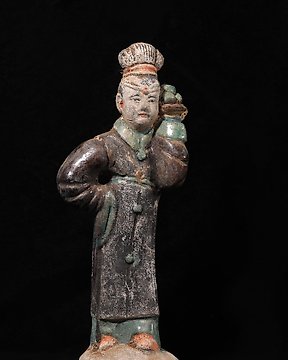
Chino antiguo Terracota Estatuilla de asistente femenina (Sin Precio de Reserva)
N.º 84323981

N.º 84323981

Foreign rider.
Chinese, Tang dynasty, 618 - 907 A.D
MATERIAL: Pottery and pigment
DIMENSIONS: 32 cm height
CONDITION: Good condition.
PROVENANCE: Private collection, Landshut, Germany, 1950.
Round sculpture made of terracotta and decorated with engobes in black and cream tones. It represents a foreign rider whose position evidences the movement and tension of the moment, with his right arm raised. He wears a suit with a jacket with collars and a pointed cap. His face evidences a violent and threatening attitude.
The Tang Dynasty was created on the 18th of June, 618 AD, when the Li family seized power from the last crumbling remnants of the preceding Sui Dynasty. This political and regal regime was long-lived, and lasted for almost 300 years. The imperial aspirations of the preceding periods and early Tang leaders led to unprecedented wealth, resulting in considerable socioeconomic stability, the development of trade networks and vast urbanisation for China’s exploding population (estimated at around 50 million people in the 8th century AD). The Tang rulers took cues from earlier periods, maintaining many of their administrative structures and systems intact. Even when dynastic and governmental institutions withdrew from management of the empire towards the end of the period – their authority undermined by localised rebellions and regional governors known as jiedushi –the systems were so well- established that they continued to operate regardless.
The artworks created during this era are among China’s greatest cultural achievements. It was the greatest age for Chinese poetry and painting, and sculpture also developed (although there was a notable decline in Buddhist sculptures following repression of the faith by pro-Taoism administrations later in the regime). It is disarming to note that the eventual decline of imperial power, followed by the official end of the dynasty on the 4th of June 907, hardly affected the great artistic turnover.
During the Tang Dynasty, restrictions were placed on the number of objects that could be included in tombs, an amount determined by an individual’s social rank. In spite of the limitations, a striking variety of tomb furnishings – known as mingqi – have been excavated. Entire retinues of ceramic figures – representing warriors, animals, entertainers, musicians, guardians and every other necessary category of assistant – were buried with the dead in order to provide for the afterlife. Warriors (lokapala) were put in place to defend the dead, while horses/ camels were provided for transport, and officials to run his estate in the hereafter. Of all the various types of mingqi, however, there are none more elegant or charming than the sculptures of sophisticated female courtiers, known – rather unfairly – as “fat ladies”. These wonderfully expressionistic sculptures represent the idealised beauty of Tang Dynasty China, while also demonstrating sculptural mastery in exaggerating characteristics for effect, and for sheer elegance of execution.
It is likely that the original purpose of the figure was that of a mingqi, terracotta figures designed to be included in a burial in order to accompany the deceased in the afterlife for protection, service and companionship.
They included daily utensils, musical instruments, weapons, armor, and intimate objects such as the deceased's cap, can and bamboo mat. Mingqi also could include figurines, spiritual representations rather than real people, of soldiers, servants, musicians, polo riders, houses, and horses. Extensive use of mingqi during certain periods may either have been an attempt to preserve the image of ritual propriety by cutting costs, or it may have a new idea separating the realm of the dead from that of the living.
Though these were particularly popular during the Tang dynasty (618-906 AD), mingqi from a broad range of historical periods have been found, with this piece acting as a particularly early example of the practice.
Notes:
The seller guarantees that he acquired this piece according to all national and international laws related to the ownership of cultural property. Provenance statement seen by Catawiki.
- The piece includes authenticity certificate.
- The piece includes Spanish Export License (Passport for European Union). NOT TAXES.
- According to Spanish legislation, items sent outside the European Union are subject to export taxes and will be added to the invoice, at the buyer's expense. These export fees are fixed on the final auction price and the tax rate is not applied directly on the total value of the item to be exported, but rather the different percentages by sections are applied to it:
- Up to 6,000 euros: 5%.
- From 6.001 to 60.000 euros: 10%.
This export permit application process can take between 1-2 months maximum.
THE MINISTRY OF CULTURE FROM SPAIN ASKS ALL SELLERS FOR INVOICES OR OTHER DOCUMENTATION ABLE TO PROVE THE LEGALITY OF EACH ITEM BEFORE PROVIDING AN IMPORT OR EXPORT LICENSE.
Cómo comprar en Catawiki
1. Descubre algo especial
2. Haz la puja más alta
3. Paga de manera segura